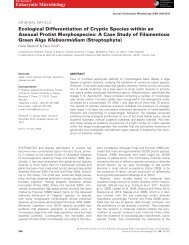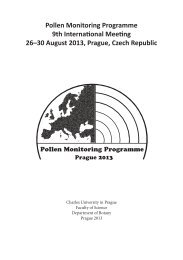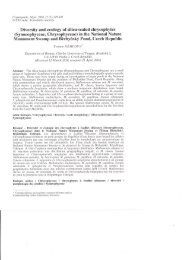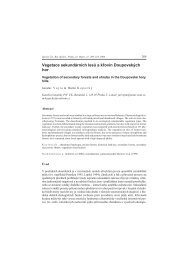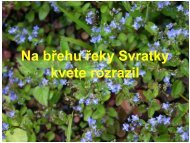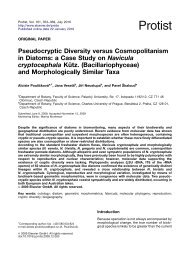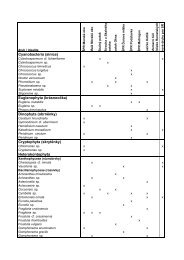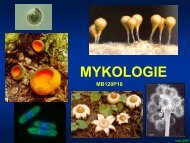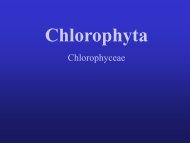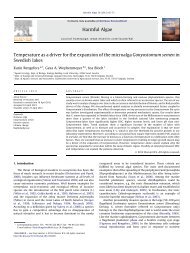Trebouxiophyceae, Chlorophyta - (S)FTP hesla na Botany
Trebouxiophyceae, Chlorophyta - (S)FTP hesla na Botany
Trebouxiophyceae, Chlorophyta - (S)FTP hesla na Botany
Create successful ePaper yourself
Turn your PDF publications into a flip-book with our unique Google optimized e-Paper software.
1.1 Traditio<strong>na</strong>l morphology<br />
General introduction<br />
Traditio<strong>na</strong>lly, green algae were classified according to the morphological species concept<br />
based on the organisation level of the vegetative state (Brunnthaler 1915; Ettl & Gärtner<br />
1988; Hindák 1977, 1980, 1984; Komárek & Fott 1983). The main morphological and structural<br />
characteristics used as taxonomic criteria in green microalgae were: form and dimensions<br />
of cells, cell wall characteristics, number of nuclei, chloroplast morphology, presence or<br />
absence of pyrenoid, number and size of autospores, and possibility to form zoospores (Ettl &<br />
Gärtner 1995; Komárek & Fott 1983). Morphological observations and species descriptions<br />
made by a number of phycologists considerably increased our knowledge of the biodiversity,<br />
morphological variability and systematics of green algae. Morphological studies of several<br />
prominent cytologists are still much accounted for their quality of observations, being sometimes<br />
at the limits of the laws of optics (Fott & Nováková 1969 1 ; Gärtner 1985; Tschermak-<br />
Woess 1989).<br />
However, recent molecular and physiological<br />
studies have demonstrated high plasticity of several<br />
morphological characters used for species delimitation<br />
and they evoked need for critical evaluation of<br />
observed morphological differences among the species.<br />
For example, presence of pyrenoid has been<br />
widely used to distinguish particular green algal<br />
species and genera, e.g. to differentiate flagellate<br />
species Chlamydomo<strong>na</strong>s and Chloromo<strong>na</strong>s (Ettl<br />
1983, Fig. 2). However, phylogenetic a<strong>na</strong>lyses revealed<br />
that strains of both traditio<strong>na</strong>l genera could<br />
belong to the same clade and, in the case of<br />
Chloromo<strong>na</strong>s reticulata, even to the same species<br />
(Buchheim et al. 1997, Pröschold et al. 2001). Nozaki et al. (1998) demonstrated that presence<br />
or absence of pyrenoids in Chlorogonium depends primarily on culture conditions (autotrophics<br />
vs. heterotrophics), instead on evolutio<strong>na</strong>ry differentiation. Similarly, production of<br />
mucilaginous envelopes around the cells, considered as discrimi<strong>na</strong>tive character of green algal<br />
family Radiococcaceae (Komárek & Fott 1983), occurs in various unrelated algal lineages<br />
(Wolf et al. 2003). Moreover, it now appears that mucilaginous production often depends<br />
rather on the environmental<br />
conditions<br />
(Buzzelli et al. 1997,<br />
Reynolds 2007) than on<br />
phylogenetic position.<br />
Another example includes<br />
the genera Chlorella<br />
and Micractinium<br />
(Fig. 3), traditio<strong>na</strong>lly<br />
classified into different<br />
families of Chlorococcales<br />
(Chlorellaceae and<br />
Micractiniaceae). The<br />
18S rDNA and ITS data<br />
revealed close relation-<br />
Fig. 2. Morphological distinction between genera<br />
Chlamydomo<strong>na</strong>s (a) and Chloromo<strong>na</strong>s (b) (modified<br />
after Ettl 1983).<br />
Fig. 3. Morphology of Chlorella vulgaris (a) and Micractinium pusillum (b) (modified<br />
after Komárek & Fott 1983).<br />
ship of these genera (Krienitz et al. 2004). Moreover, formation of colonies and cell wall bris-<br />
1 cited paper has presently 114 citations in WOS (ISI Web of Science, http://portal.isiknowledge.com/portal.cgi)<br />
2



